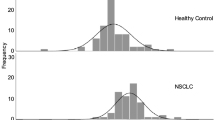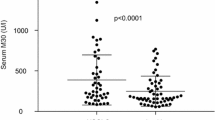Abstract
Background
M30 and M65 are derivatives of cytokeratin 18 and released from the epithelial cell during cell death. These markers can be used to evaluate prognosis and chemotherapy response in several tumours. We evaluated serum M30 and M65 values in patients with advanced non-small-cell lung cancer (NSCLC) compared with those in a healthy group.
Material and methods
Thirty-two patients with advanced NSCLC and thirty-two healthy people were included in the study. Serum M30 and M65 values were measured by quantitative ELISA method. The best cut-off value for serum M65 was calculated by ROC analysis and then univariate analysis was performed to determine the importance of M65 value in predicting progression-free survival (PFS).
Results
There were no differences between mean serum M30 values between patients and controls (445.44±536.17 vs. 340.56±345.07, p=1). The mean serum M65 values were found to be significantly higher in patients than in healthy controls (1421.30±1662.59 vs. 648.85±341.17, p<0.001). The best cut-off value for serum M65 predicting PFS was 1311.64 U/l (AUC 0.58, sensitivity and specificity were 45.5% and 85.7% respectively). The patients with serum M65 values ≥1311.64 U/l had worse PFS than patients with serum M65 values <1311.64 U/l, p=0.01). There was no correlation between serum M30 value and PFS in the patient group (p=0.4).
Conclusions
Our results indicated that serum M65 values elevated in advanced NSCLC compared to a healthy control group and elevated serum M65 level can predict PFS in patients.
Similar content being viewed by others
References
Yaman E, Coskun U, Sancak B et al (2010) Serum M30 levels are associated with survival in advanced gastric carcinoma patients. Int Immunopharmacol 10:719–722
Dive C, Smith RA, Garner E et al (2010) Considerations for the use of plasma cytokeratin 18 as a biomarker in pancreatic cancer. Br J Cancer 102: 577–582
Sheard MA, Vojtesek B, Simickova M, Valik D (2002) Release of cytokeratin-18 and -19 fragments (TPS and CYFRA 21-1) into the extracellular space during apoptosis. J Cell Biochem 85: 670–677
Kramer G, Erdal H, Mertens HJ et al (2004) Differentiation between cell death modes using measurements of different soluble forms of extracellular cytokeratin 18. Cancer Res 64:1751–1756
Ueno T, Toi M, Linder S (2005) Detection of epithelial cell death in the body by cytokeratin 18 measurement. Biomed Pharmacother 59:359–362
Cummings J, Ranson M, Butt F et al (2007) Qualification of M30 and M65 ELISAs as surrogate biomarkers of cell death: long term antigen stability in cancer patient plasma. Cancer Chemother Pharmacol 60:921–924
Ulukaya E, Yilmaztepe A, Akgoz S et al (2007) The levels of caspase-cleaved cytokeratin 18 are elevated in serum from patients with lung cancer and helpful to predict the survival. Lung Cancer 56:399–404
Olofsson MH, Ueno T, Pan Y et al (2007) Cytokeratin-18 is a useful serum biomarker for early determination of response of breast carcinomas to chemotherapy. Clin Cancer Res 13:3198–3206
Ausch C, Buxhofer-Ausch V, Olszewski U et al (2009) Caspase-cleaved cytokeratin 18 fragment (M30) as marker of postoperative residual tumor load in colon cancer patients. Eur J Surg Oncol 35:1164–1168
Ozturk B, Coskun U, Sancak B et al (2009) Elevated serum levels of M30 and M65 in patients with locally advanced head and neck tumors. Int Immunopharmacol 9:645–648
Ueno T, Toi M, Bivén K et al (2003) Measurement of an apoptotic product in the sera of breast cancer patients. Eur J Cancer 39:769–774
de Haas EC, di Pietro A, Simpson KL et al (2008) Clinical evaluation of M30 and M65 ELISA cell death assays as circulating biomarkers in a drugsensitive tumor, testicular cancer. Neoplasia 10: 1041–1048
Ginsberg MS, Grewal RK, Heelan RT (2007) Lung cancer. Radiol Clin North Am 45:21–43
Jemal A, Siegel R, Ward E et al (2009) Cancer statistics, 2009. CA Cancer J Clin 59:225–249
Goldstraw P, Crowley J, Chansky K et al; International Association for the Study of Lung Cancer International Staging Committee; Participating Institutions (2007) The IASLC Lung Cancer Staging Project: proposals for the revision of the TNM stage groupings in the forthcoming (seventh) edition of the TNM Classification of malignant tumours. J Thorac Oncol 2:706–714. Erratum in: J Thorac Oncol 2007;2:985
Wu YX, Wang JH, Wang H, Yang XY (2003) [Study on expression of Ki-67, early apoptotic protein M30 in endometrial carcinoma and their correlation with prognosis] [Article in Chinese]. Zhonghua Bing Li Xue Za Zhi 32:314–318
Hou JM, Greystoke A, Lancashire L et al (2009) Evaluation of circulating tumor cells and serological cell death biomarkers in small cell lung cancer patients undergoing chemotherapy. Am J Pathol 175:808–816
Ausch C, Buxhofer-Ausch V, Olszewski U et al (2009) Circulating cytokeratin 18 fragment m65-a potential marker of malignancy in colorectal cancer patients. J Gastrointest Surg 13:2020–3026
Koelink PJ, Lamers CB, Hommes DW, Verspaget HW (2009) Circulating cell death products predict clinical outcome of colorectal cancer patients. BMC Cancer 9:88
Erler JT, Cawthorne CJ, Williams KJ et al (2004) Hypoxia-mediated down-regulation of Bid and Bax in tumors occurs via hypoxia-inducible factor 1-dependent and -independent mechanisms and contributes to drug resistance. Mol Cell Biol 24: 2875–2889
Greystoke A, Cummings J, Ward T et al (2008) Optimisation of circulating biomarkers of cell death for routine clinical use. Ann Oncol 19:990–995
Author information
Authors and Affiliations
Corresponding author
Rights and permissions
About this article
Cite this article
Oven Ustaalioglu, B., Bilici, A., Ercan, S. et al. Serum M30 and M65 values in patients with advanced stage non-small-cell lung cancer compared with controls. Clin Transl Oncol 14, 356–361 (2012). https://doi.org/10.1007/s12094-012-0808-0
Received:
Accepted:
Published:
Issue Date:
DOI: https://doi.org/10.1007/s12094-012-0808-0




